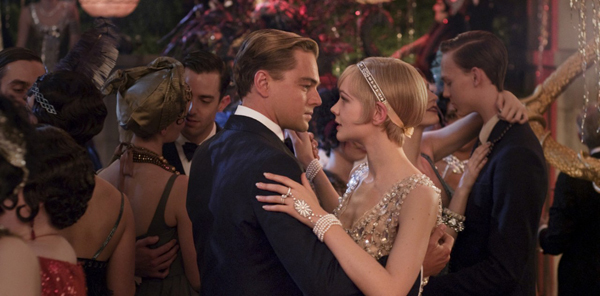The Great Gatsby
This is very much the version that Jay Gatsby would want to watch, rather than one that Fitzgerald would.
Plot summary
The Great Gatsby follows Nick Carraway as he leaves the Midwest and comes to New York City in the spring of 1922, an era of loosening morals, glittering jazz, bootleg kings, and sky-rocketing stocks. Chasing his own American Dream, Nick lands next door to a mysterious, party-giving millionaire, Jay Gatsby, and is drawn into the captivating world of the super rich, their illusions, loves and deceits.

Baz Luhrmann’s Gatsby was always going to be a Marmite proposition. His maximalist approach as a director can either make a film (Romeo + Juliet) or break it (Australia), and The Great Gatsby has been anticipated with varying degrees of excitement and forboding ever since the trailer appeared a year ago. The delays to release haven’t helped – Jay-Z was a high profile addition to the post-production effort, and not one that offered much reassurance to the legions of Fitzgerald fans out there. Plus filming such a literary novel in 3D seemed like an additional weight to put on a feature that would make a natural period chamber-piece.
Though these decisions seem jarring and commercial at first appraisal, when combined with a faithful script, high production values and excellent performances, they create an eccentric artistic statement. Whether it’s a statement you’ll relish is another matter: this is ‘Gatsby’ on a cocaine binge. Every scene booms with either cinematic portent or a glitter cannon, and the effect is stunning in every sense of the word.
We begin with Nick Carraway (Tobey Maguire), who is holed up in sanatorium and relating his tale to a therapist. This is one of the few plot tweaks, and though clunky it is a functional solution to the perennial voiceover problem. We’re quickly thrown into the story by way of swooping views of Long Island, introductions to Daisy and Tom Buchanan (Carey Mulligan and Joel Edgarton, both strong) and Nick’s reflections on the youthful excesses of the 1920s, which are adroitly illustrated through a rambunctious party presided over by Tom’s mistress Myrtle (Isla Fisher, in full Clara Bow flapper mode).
The stage is set, but it isn’t until Leonardo Di Caprio makes his first appearance as the much-anticipated Gatsby that things begin to work. The hilarious and demented overstatement that Luhrmann packs into this moment is a sight to behold, and Di Caprio justifies the introduction by making Gatsby glow with a studied charm that fails to conceal his visible straining for acceptance. His friendship with Nick is oddly touching – perhaps because Maguire’s Nick is gauche and wide-eyed, rather than coolly distant. That warmth comes across in Gatsby’s love for Daisy too – it feels more romantic, less transactional. This undermines the cautionary moral of the story (tellingly, Gatsby never says his famous line “her voice is full of money”), but the chemistry between the lovers make her ultimate betrayal feel more potent as a result.
Nothing is left unspoken or unseen, which will repel those expecting subtlety. Luckily, a subtle (and many argue, dull) version came out in 1974 courtesy of Jack Clayton, and Luhrmann’s explicit approach amplifies certain elements of the novel – the offensive, raw newness of Gatsby’s wealth, the shadiness of his gangster underworld, and the sense of social mobility that energised New York City in the 20s to name a few. Some symbols are overplayed tiresomely (the optician’s billboard, the green light across the bay) and Maguire’s voiceover is not only present, it also makes unwelcome appearances as actual text on screen – but the desire to do the story justice is palpable.
The film runs for almost two and a half hours; long for a novella adaption perhaps, but a comfortable amount of time to spend with a much-loved classic (see also: The Hobbit, Les Miserables). Most people who’ve read ‘The Great Gatsby’ were introduced to it in school, as another bit of homework to be tested on – much like ‘Romeo and Juliet’ in fact. And Lurhmann’s vivid treatment of that text has made it the de facto screen adaptation for classroom viewings. I suspect he’s done the same again for Fitzgerald’s story; all the care and time devoted to each set piece makes the whole feel like a kaleidoscope filled with Moments of Great Significance. Meanwhile the confident, disconcerting throb of Jay-Z’s music proves effective, giving scenes the edge that jazz once held 90 years ago. The result is an immense spectacle for teenagers – there’s little sense of perspective or true insight, only parties, passions, and desperate longing.
There’s a great deal going on; some of it works, some of it doesn’t. It’s very much the version that Jay Gatsby would want to watch, rather than one that Fitzgerald would – given the subject matter, it’s ironic that the book’s introspection falls by the wayside as the astronomical budget is thrown at gorgeous clothes and a barrage of special effects. But making an entertaining and immersive film from such a hallowed literary text is a tall order, and credit is due to the filmmakers for throwing caution to wind and making something as quixotic as this.











COMMENTS